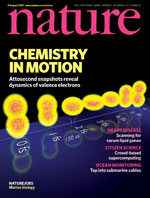Looking at sheer numbers, science writing is in a boom, enabled by the relative ease of publishing on the internet. Just looking at condensed matter physics and related areas such as nanotechnology, there are wonderful blogs such as 2020 Science, Condensed Concepts, nanoscale views, Soft Machines, and Uncertain Principles. If you do not follow them already, I suggest you take a look.

(c) Intel
But despite all the exciting developments in the field, condensed matter physics is not as much in the limelight as say, the LHC or personal genomics. And this despite revolutionary techniques that have a profound impact on our daily life: the transistor, semiconductor lasers, computer hard drives, or the latest advances in nanotechnology, to name but a few.
A few weeks ago, Chad Orzel wrote about this problem in his blog, mentioning that comparatively few people write about the exciting discoveries in condensed matter physics. Doug Natelson took this further and identified a number of problems related to the perceived relevance and profundity of the field, as well as the issue of accessibility for a field whose scientific concepts are often difficult to relay to non-experts.
In my opinion these are of course all valid points, but not impossible to overcome. Of course, it can be a difficult topic to write about. But we need to get the message out more often, so that it sticks better. The problem is certainly not a lack of people in the field. Condensed matter physics researchers make up the majority of members of the American Physical Society. The large body of research they create certainly provides plenty of material to write about.
I have been pondering about the launch of a blog for a while, but constraints on my time have always put me off the idea. However, this recent discussion has finally convinced me that a blog in this area might be of benefit.
In comparison to writers such as Doug and Chad, who are respected university professors, I can offer a slightly different perspective, namely that of an editor of a scientific magazine with experience in research areas ranging from condensed matter physics to chemistry, nanotechnology, materials science and photonics. I frequently discuss current trends and opinions with researchers in these fields. By launching this blog, I hope to bring you some of the exciting stories in this field and hope to increase the interest in a research area that is so relevant to the technologies that we use in our daily life.




August 9, 2010
2 Comments